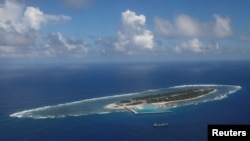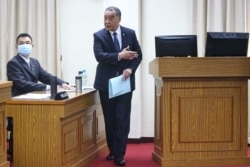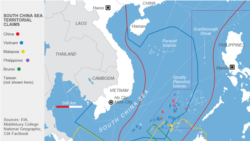Taiwan’s military has stepped up training of troops and added defensive weaponry on the contested South China Sea’s biggest natural island to prepare for any attack by Beijing, analysts believe.
Defense Minister Chiu Kuo-cheng told parliament March 17 China was “capable” of attacking and that he wanted Taiping Island “to be ready at all times,” local media reports said. He was referring to a sparsely populated feature in the Spratly archipelago that is located 1,500 kilometers southwest of Taiwan and disputed by five other governments, including China.
“That signals unequivocally that Taipei is concerned and takes China’s ambitions, statements and actions — reaffirming that Beijing intends to [capture] the island — very seriously,” said Fabrizio Bozzato, senior research fellow at the Tokyo-based Sasakawa Peace Foundation’s Ocean Policy Research Institute.
China has alarmed Taiwan since mid-2020 by sending military aircraft almost every day over a corner of Taiwan’s air defense identification zone. On Friday, the defense ministry spotted 20 planes, an unusually high count. China has added hangars and radar systems to its own seven holdings in the Spratly chain over the past decade.
Taiping Island, an outpost also known as Itu Aba, would be easier for China to take compared to Taiwan because it covers just 46 hectares (110 acres), some analysts say. The tropical landform supports an air strip, a pier and a small hospital.
To “strain and exhaust Taiwan’s air crew and sailors” and “aggravate” Taiwan’s citizens, China could “demonstrate its power by invading one or another offshore island controlled by Taiwan” including Taiping, the research organization Council on Foreign Affairs said in a special report last month.
The Beijing government claims self-ruled Taiwan as part of its territory, a leftover issue from the Chinese civil war of the 1940s, and it has not ruled out the use of force to unify the two sides.
Taiwanese have told government polls they prefer autonomy over unifying with China. Taiwan President Tsai Ing-wen rejects Beijing’s “one-China” principle as a condition for any dialogue. The two sides have not spoken formally since 2016.
Brunei, Malaysia, the Philippines and Vietnam claim all or parts of the South China Sea, as well. Vietnam, worried about China as well, has landfilled its Spratly holdings over the past two years and the Philippines asked this month that China withdraw about 200 fishing boats from the archipelago. The six claimants look to the sea for fisheries and undersea fuel reserves.
Vietnam warily eyes Taiwan’s development on Taiping Island but it is not considered a threat.
Beijing cites historical usage records to back its Spratly claims and has alarmed the other South China Sea claimants by developing islets for military infrastructure. China maintains the world’s third largest armed forces and ships occasionally rile Southeast Asian states by entering their exclusive economic zones.
Taiwan further bulked up last week by signing a coast guard cooperation memorandum of understanding with the United States. The two sides said Thursday they would create a working group to build cooperation and share information. Taiwan’s coast guard is in charge of protecting Taiping Island.
The U.S. government already sells advanced weapons to Taiwan and has the option of defending it if attacked. Washington recognizes Beijing diplomatically but remains Taiwan’s staunchest informal ally. China resents U.S. help for Taiwan and condemned last week’s coast guard agreement.
“Taiwan is definitely a spot between the U.S. and China, and also cross-Strait relations are really deteriorated,” said Wang Wei-chieh, Taiwan-based analyst and co-founder of the FBC2E International Affairs Facebook page. When considering the threat of war, he said, “we are not really scared of it, but we are also prepared for it.”
There is no immediate “reason” for China to attack Taiping Island, Wang said.
China has not said it plans to attack any Taiwanese holdings and on March 4 Chinese Premier Li Keqiang said his government was committed to “peaceful growth of relations”. Chinese officials base their own claim to 90% of the disputed 3.5 million-square-kilometer sea on a demarcation line established by Taiwan’s constitutional government, the Republic of China.
“How could it attack Taiping Island? China is doing everything possible to create an impression that the two sides are united fighting against outsiders including the United States, Vietnam and the Philippines,” said Chao Chien-min, dean of social sciences at Chinese Culture University in Taipei. “If they want to strike, it won’t be there.”













